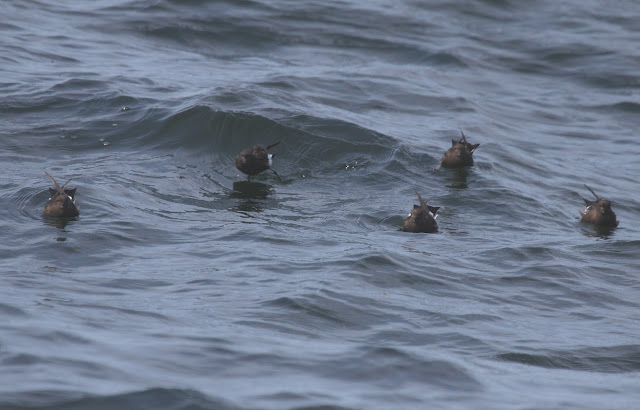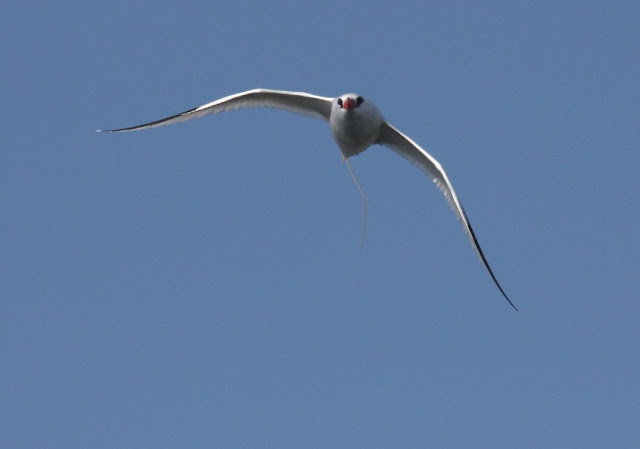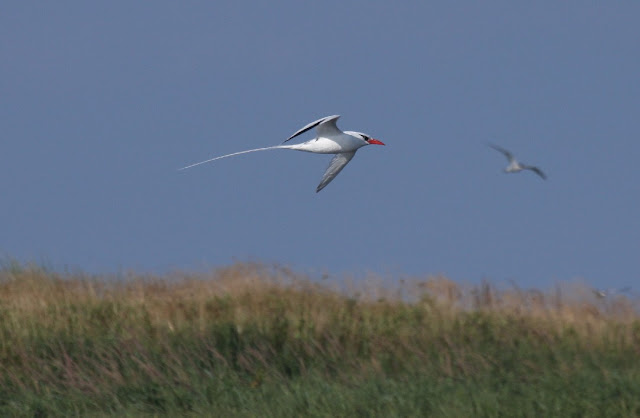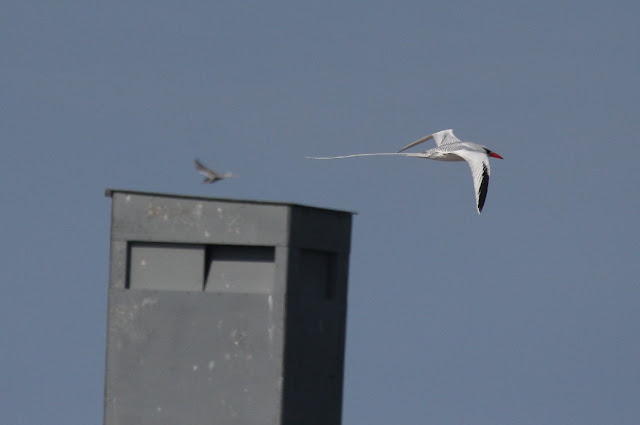Part 3- The Quest for the Red-Billed Tropicbird Continues-
Monday, July 23, 2012- Another bright sunny and windy morning. The sunrise over the harbor was fabulous with not a hint of a cloud in the sky. However the wind had picked up a bit, and listening to the weather didn’t make it much better. Jen and I explored the Island a bit more, and walked some of the Nature Preserves. Lanes Island Nature Preserve was one that we liked. It was located a short distance from the Motel and overlooked the outer reaches of Carvers Harbor Seal Island
While Jen and I were in the Preserve that morning, we had a great view of the outer Islands from the bluff on the point. The ocean was quite rough with large breaking sea engulfing the ledges and small islets; I was doubting whether we would be getting out or not. As the tide rose, the seas got heavier. Hopefully when the tide changed, so would the wind (decreasing I hoped)! After a wonderful morning walking in the Preserve, and after a quick lunch, we again found ourselves at the town dock. While we sat there on the bench talking with Mr. Goodwyn, I started noticing that with the tide change the flags in the harbor had dropped a bit, and the wind changed a bit so’ easterly; we had just been given a gift!
At just about 2:00 pm, the Fluke passed by the end of the pier, and John greeted us with a wave and a friendly smile.
On the way out of the Harbor, I asked John how his morning run went. The ornithologists, biologists, and researchers who do their research and studies on Seal Island and Matinicus Rock rely on John to shuttle them back and forth to the Islands . John had a run to both Islands (and he graciously invited me to ride along) that morning. He told me that the run to Seal was worse than it was the day before with us, in fact he wasn’t able to deliver the researchers to Matinicus that morning; way too rough. So he had to bring them back and try for another day. As we cleared the inner islands, a very satisfying flat sea greeted us.
John steered the Fluke towards the Roberts Islands Maine and in Alaska
Little Roberts Island US Maine
Part of the Great Cormorant nesting colony on Little Roberts Island-
The Double-crested Cormorant colony –
On the way out to Seal, a few Gannets were seen, although not as many as the day before-
About halfway to Seal Island Wilson
This adult Great Cormorant is banded-
Hen Eider with brood-
A single Raven harasses the Tern colony-
Here are the Puffins…..
……this one was banded-
Arctic and Common Terns-
Puffins on top the boulders-
The largest concentration of Puffins and a few Razorbills continued off the northeast point of Seal Island-
Four Razorbills-
It was time to set the Tropicbird decoy. John decided it would be best to set it closer to the Island than it was yesterday-
I started rigging my alcid decoys and John suggested not to use the Razorbill decoy in the line. He told me that Razorbills are a bit more aggressive and intimidating to Puffins, the Murres would be a better choice. Although we did have quite a few Puffins drop into the decoys the day before, many didn’t. With the five alcid decoys (2 Puffin, 2 Common Murre and 1 Black Guillemot) secured to the mainline, I fed them over the stern letting the tide carry them away from the Fluke. Before the decoys drifted far enough away from the boat, the first Puffin dropped in, and that continued all afternoon. Looks like next year, I will have to carve more Puffin and Murre decoys to bring with me; we are always learning!-
Kleptoparasitism at sea- This Laughing Gull was unsuccessful chasing these Terns trying to steal the fish-
But this one however was successful. John and I looked at the Gull with a Rock Gunnel in its bill. We both looked at each other at the same time knowing a Black Guillemot was the victim. John said “I wonder where he got that”??
Half the fun in watching seabirds is to see if you can figure out what food item they have captured. This Black Guillemot has an interesting menu item; a Shrimp!-
More flocks of Semi-palmated Sandpipers-
This pair of Puffins stayed together in flight-
This Black Guillemot flew by us heading for its nest burrow (notice the Short-billed Dowitcher)?-
After it swam by the decoys, this Black Guillemot came fairly close to us…..
…..peering underwater…..
…..and the dive. Love those Coral Red tarsii!
Short-billed Dowitchers-
It was now around 4:30 in the afternoon, and still no Tropicbird. I was growing very anxious and I started thinking that maybe it wasn’t in the cards for Jen and me. Looking over to Jen, I could see that she was having a great time (she loves Puffins) and there were plenty of them. But I knew she was a bit disappointed for me. John mentioned that if the bird doesn’t show up by 5:00 pm, it would be too late.
I decided to quell my anxiety by coming to terms with the fact that the bird just might not show up! I asked John to tell me about the history of this bird at Seal Island
I asked John about the bird’s routine, and he told me about the bird. He said it can show up from any direction, but often spots it coming from the northeast or east. The bird appears to enjoy harassing the Terns on the Island and gives a great show doing this. John pointed to the small shack headquarters that the researchers use and said that there was a small brackish pond behind there. The Terns often congregate on this pond. When the Tropicbird shows up it will make several strafing flights over this pond which of course will scatter the Terns. Often after many strafing runs, the Tropicbird will land and sit on the sea for a short time, before making the flights again. As he told this to Jen and me, we looked at each other and hoped that we would witness this; it would be incredible!
The fact that this bird has made Seal Island Caribbean Islands from the West Indies, Puerto Rico to Tobago . For information on nesting seabirds, here is my favorite book on seabirds: An Inventory of Breeding Seabirds of the Caribbean . The Red-billed Tropicbird (Phaethon aethereus mesonauta) is also known as the “Boatswain Bird” by sailors and merchant mariners. It also has many other regional names such as Payanke (“straw in tail”) in the Seychelles , and “Rabijunco Piquirrojo” in Costa Rica Bermuda outshining its indigenous breeding cousin the White-tailed Tropicbird.
I had resigned myself to lessening my anxiety regarding the Tropicbird’s appearance by focusing on other birds. I was sitting at the stern watching the many Puffins landing in my decoys. One of the Puffins flew by the decoys, turned around and circled over the Island and dropped right in line with the decoys. I turned to Jen who was sitting in the shade of the wheelhouse and asked her if she saw that bird, which she did. I looked back as a pair of Puffins were flying directly towards the decoys. I just raised my camera to take pictures when John’s voice calmly said “Hello”….! I looked back to see him as he walked out from the wheelhouse pointing to the northeast over Seal Island Island , and John said “here it comes”! I found the bird immediately and took this picture (the first one) as it crossed Seal Island
I definitely felt my heart rate rise as this gorgeous and rare sea bird made its appearance thousands of miles from its normal home range. I could hardly keep the camera pointed at the bird, let alone centered in the viewfinder! I could feel my hands trembling as I fumbled at the shutter button. It was very hard suppressing my breathing to ensure my 400 mm lens would be steady (my heart is racing now as I write this)! A thought occurred to me while I followed the bird, did I have the camera set correctly? It was a bright sunny afternoon and I had been shooting black plumaged Guillemots and Puffins. Now I have this rare white bird in the same bright sun, will the images be washed? At this point I kept shooting, I figured I can always bring them back a little with photo shop. I followed the bird as it came closer flying right up the heart of Seal Island
But even more amazing, the bird turned directly at us, and made a quick pass right over the bow of the Fluke, backlit slightly by the sun!
The Tropicbird made a few more strafing runs over the pond, and again, it swung in our direction, but this time it flew over the mid ship of the Fluke only a few yards over our heads! Unbelievable! Jen and I gave each other a big hug, we were so excited! I turned to John and gave him a firm handshake (and a little pat on the back) and a great big THANK YOU!!
The Tropicbird continued with many strafing runs over the Island . I started wondering if the bird was actually seeing the decoy? Maybe it did! John and I were hoping that the bird would land next to the decoy; that would be incredible.
I had taken many hundred images of this bird and the Tropicbird seemed to enjoy giving us a show. It wheeled around continually and made several more passes over us, I decided as a bit of insurance to change memory cards; I didn’t want all the images of the bird to be on one card just in case. I was changing the camera card when Jen said very excitedly “Here it is”! I looked up just in time to take a few images of the bird crossing by me at the stern with the late afternoon sun in perfect position for pictures. The bird was stunning!!-
The bird stayed with us for awhile. It made a few long and wide flights over the sea to the northeast and passed over us many times.
Another hope or expectation (beyond seeing this magnificent seabird) of mine was to photograph this bird in the same image with my decoy. We were all talking about the bird when John said that the bird was coming right at us “straight off the stern”. I kneeled down using the stern as a brace for the lens. The Tropicbird seemed to be flying a little starboard of us when it suddenly veered right at us. The bird appeared to be zeroing in on the decoy. I know John was behind me trying to telepathically coax the bird into the decoy! As the bird drew closer, I got my shots!-
As the Tropicbird passed by my decoy, John said that it looked like it was going to land on the sea, and that is just what it did! The bird settled in not more than thirty yards away from my decoy all the time calling loudly-
When the Tropicbird crossed by closer to the decoy, it seemed to look over to check it out-
The bird sat for only a minute or two and then off again making more passes over the Island and us. It landed on the sea near my decoy again, and also made a few passes over its burrow. John thought the bird was going to land there, but instead appeared to be checking it out making sure it was safe. The Tropicbird eventually flew off to the east after giving us a two hour show!
John told me that it was just about the longest time he had seen the bird at Seal. Jen and I felt really blessed! We stayed for another half an hour reflecting on this amazing experience ( I think I shook John’s hand a dozen times) with this breathtaking bird….and that’s exactly what it did! Even now as I write this report, I am re-living this amazing experience again; Jen and I will never forget it!
We decided to head in, so we untied the Fluke and gathered up my decoys. I asked John if he would pass by the northeast point one more time; a kind of maritime keepsake, and he obliged. The large flocks of Puffins were still there, many Black Guillemots as well, and the Terns still circled overhead. Jen and I said good-bye (for this year) to Seal Island Island-
During the day, John mentioned that lately he was seeing a few two-year old Puffins around the Island . These birds had a smaller bill, less color and dark face plumage. He pointed out two on that day, but I was unable to get any images. Just as the Shearwater left, he pointed to the port side as a single Puffin crossed by me. I snapped a few quick images of the bird which was another two-year old Puffin-
The ride back was smooth. A Greater Shearwater crossed the bow, followed by three more in a span of a few hundred yards-
Within a few minutes of the Greater Shearwaters, John pointed out from the wheelhouse calling “Manx”! By the time I located the bird, it was off in the distance. This is the only (poor) shot I was able to take-
There were many Black Guillemots, a handful of Wilson
Brimstone Island and its black cobble beach- it reminded me of
We were approaching the outer ring of Islands , and John mentioned that he had found an all-white Greater Black-backed Gull which he called an “Ivory Black-backed Gull” on Little Brimstone Island. Approaching the cut between Brimstone and Little Brimstone, Black Guillemots and Common Eiders were present in good numbers-
John slowed down the throttle on the Fluke and started looking on the Islands black cobblestone shore through his binoculars. There was a large Gull roost there and that is where he had first found the Gull. As if on cue, John exclaimed that he found it-
We enjoyed the Gull for a few minutes and then back on our way. As we passed by Brimstone Island Jen spotted an Eagle being chased by a Gull; it was heading back to Otter Island-
We pulled back into the harbor and to the dock to a setting sun-
The three of us sat there for a few minutes reminiscing about the day. The Tropicbird gave us an amazing show as did all the other seabirds. Jen and I had a completely unbelievable summer seabirding experience. John gave us an amazing opportunity to see the Tropicbird, and we are extremely grateful to him. Even though Jen and I feel that this bird is synonymous with John; John humbly regards the bird as a friend and fellow traveler. With John's help, everyone can and should enjoy this amazing traveling Tropical seabird.
As we unloaded our gear, we met his son who stopped by the dock to see John. We said our good-byes, wished him well, see you next year, and said another very heart-felt THANK YOU!
As we unloaded our gear, we met his son who stopped by the dock to see John. We said our good-byes, wished him well, see you next year, and said another very heart-felt THANK YOU!
I can honestly say that I have met and been with many bird guides through the years, but two really stand out. To Jen and me it goes deeper than the bird, it goes to the heart of the experience and the person’s willingness to share their knowledge, passions and their love for the birds. The two best birding guides I have met are Merino Chacon from Savegre Mountain Hotel (http://www.savegre.com ) in San Gerado de Dota, Costa Rica (Quetzal expert) and John Drury from Vinalhaven , Maine New England summer seabirds, but mostly for the Red-billed Tropicbird! Thank You John, and Merino!
To contact John directly:
John Drury Ph# (Nov – April) 207 863 4962
For this great opportunity and for what he offers the cost of his services are extremely reasonable. His knowledge is unmatched as well as his seabirding passion! You can contact John directly at the contact info above, or as I mentioned earlier in this report, Jen and I are going back next year with John and we will be putting a group trip together. If you are interested please email me, I will contact you later in the year with the details. Going out with John should not be missed!
Birding Highlights for Monday, July 23 (rough estimates)- 1 RED-BILLED TROPICBIRD, 150 Common Eider, 2 Common Loon, 5 Great Shearwater, 1 Manx Shearwater, 40 Wilson’s Storm-Petrel, 23 Northern Gannet, 150 Double-crested Cormorant, 18 Great Cormorant, 7 Osprey, 5 Bald Eagle, 2 Spotted Sandpiper, 25 Semi-palmated Sandpiper, 7 Short-billed Dowitcher, 35 Laughing Gull, 1 “Ivory” Black-backed Gull, 400 Common Tern, 24 Arctic Tern, 6 Razorbill, 75 Black Guillemot, 350 Atlantic Puffin, 1 Common Raven
Great Cormorant nesting colony (red arrow)-
The brackish pond on Seal Island NWR and direction of the Tropicbird’s strafing flight-
The location of the Fluke and my decoys (orange arrow) and the brackish pond location (green arrow)-
The “Ivory” Black-backed Gull (yellow arrow)-
Part 4- Enjoying Vinalhaven continues…..click on “Older Posts” below right





















































































































































































































